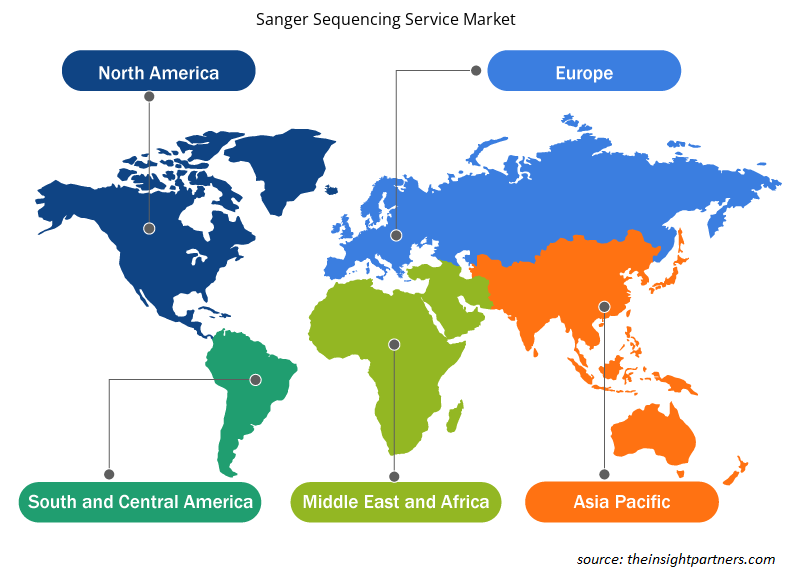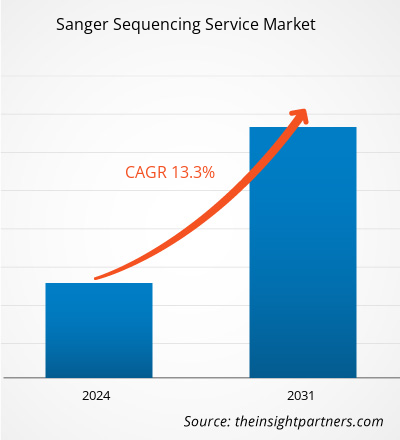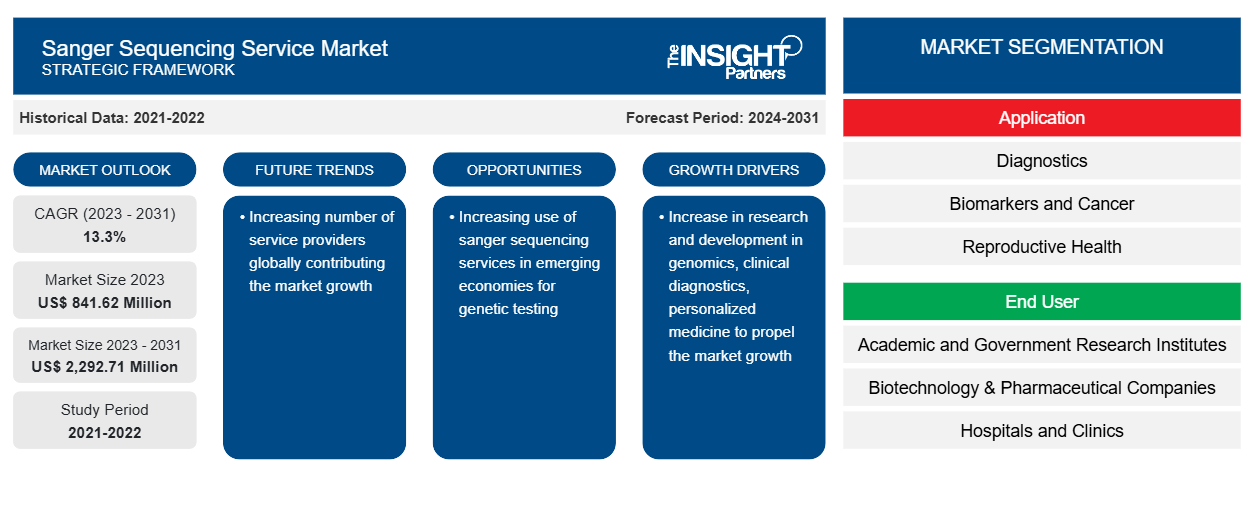Se proyecta que el tamaño del mercado de servicios de secuenciación de Sanger alcance los 2292,71 millones de dólares estadounidenses en 2031, frente a los 841,62 millones de dólares estadounidenses en 2023. Se espera que el mercado registre una CAGR del 13,3 % durante el período 2023-2031. Es probable que el aumento de la cantidad de secuenciación de próxima generación y la adopción de la automatización y la robótica sigan siendo tendencias clave en el mercado.
Análisis del mercado de servicios de secuenciación de Sanger
El mercado de servicios de secuenciación de Sanger está impulsado por la creciente investigación y desarrollo en genómica, que incluye la secuenciación genómica, la elaboración de perfiles de expresión génica y el análisis de la variación genética. La secuenciación de Sanger sigue siendo una herramienta valiosa para la validación de datos de NGS, la secuenciación genética dirigida y otras aplicaciones específicas de investigación genómica. Además, también se espera que la creciente adopción de diagnósticos clínicos y medicina personalizada contribuya al crecimiento del mercado. La secuenciación de Sanger desempeña un papel importante en el diagnóstico clínico para identificar mutaciones genéticas asociadas con trastornos genéticos, cáncer y otros trastornos. Además, la creciente adopción de la medicina personalizada y la necesidad de pruebas genéticas precisas están contribuyendo al crecimiento del mercado. Sin embargo, se espera que el uso creciente de los servicios de secuenciación de Sanger en las economías emergentes cree amplias oportunidades para el crecimiento del mercado en los próximos años.
Descripción general del mercado de servicios de secuenciación de Sanger
Se espera que el mercado de servicios de secuenciación de Sanger registre una tasa de crecimiento significativa debido al aumento de la investigación y el desarrollo en genómica, diagnósticos clínicos , medicina personalizada y otros, junto con un número cada vez mayor de proveedores de servicios a nivel mundial. Además, se espera que el uso creciente de los servicios de secuenciación de Sanger en las economías emergentes cree oportunidades en los próximos años. El segmento de biomarcadores y áreas de aplicación del cáncer representa la mayor participación de mercado debido a la creciente incidencia del cáncer, el aumento de la investigación sobre biomarcadores del cáncer y el aumento del uso de biomarcadores del cáncer en el descubrimiento y diagnóstico de fármacos. Además, en 2023, América del Norte representa la mayor participación en el mercado mundial de servicios de secuenciación de Sanger y se proyecta que tendrá la mayor participación de mercado durante el período de pronóstico. El crecimiento del mercado de servicios de secuenciación de Sanger en esta región está impulsado principalmente por el aumento de la investigación sobre el cáncer, la financiación y los desarrollos para la genómica y la medicina de precisión. Sin embargo, Asia Pacífico es la región de más rápido crecimiento debido a las crecientes actividades de investigación y la creciente presencia de los principales actores del mercado que impulsan el crecimiento en la región de Asia Pacífico.
Personalice este informe según sus necesidades
Obtendrá personalización en cualquier informe, sin cargo, incluidas partes de este informe o análisis a nivel de país, paquete de datos de Excel, así como también grandes ofertas y descuentos para empresas emergentes y universidades.
-
Obtenga las principales tendencias clave del mercado de este informe.Esta muestra GRATUITA incluirá análisis de datos, desde tendencias del mercado hasta estimaciones y pronósticos.
Impulsores y oportunidades del mercado de servicios de secuenciación de Sanger
Aumento de proveedores de servicios y aplicaciones de secuenciación de Sanger para favorecer el mercado
Las empresas que ofrecen servicios de secuenciación Sanger están ampliando su alcance global en el mercado y también desempeñan un papel importante en el aumento de la adaptabilidad de las tecnologías de secuenciación en todo el mundo. Por ejemplo, en junio de 2023, Source Genomics, parte del grupo Source BioScience, abrió un nuevo laboratorio en el norte de Inglaterra. Esto proporcionará el servicio de secuenciación Sanger líder en la industria de Source Genomics al territorio del norte con tiempos de respuesta más rápidos para una entrega de datos optimizada.
Además, en los últimos años, el sistema CRISPR-Cas9 se ha establecido como la técnica de edición en organismos complejos. Este sistema se considera en gran medida como una opción debido a las ventajas que ofrece, como la relación coste-beneficio, la facilidad de uso y la alta eficacia de las ediciones dirigidas deseadas. Sin embargo, en los experimentos de edición del genoma, el proceso de reparación no es completamente preciso; por lo tanto, se utilizan el análisis de fragmentos o la secuenciación de Sanger por electroforesis capilar (CE) para determinar la eficiencia de la edición del genoma mediada por CRISPR en cultivos de células transformadas primarias. Además, la secuenciación de Sanger también se utiliza para determinar eventos de edición exitosos en clones secundarios. Por lo tanto, el uso creciente de la secuenciación de Sanger en diferentes aplicaciones impulsará el mercado de servicios de secuenciación de Sanger.
Aumento de las aplicaciones en las economías emergentes
Los mercados emergentes de los países en desarrollo de la región Asia Pacífico están creando mejores oportunidades para que los principales actores del mercado expandan sus negocios. La mayoría de los principales actores se concentran en mercados emergentes como India, China y otros. Como tienen una gran población y los avances tecnológicos en estos países también favorecen el crecimiento del mercado.
Además, es probable que el creciente sector de la atención sanitaria en esta región mejore las oportunidades de crecimiento del mercado de pruebas genéticas prenatales y neonatales. Por ejemplo, es probable que el creciente número de hospitales corporativos como Apollo Group, Max, Fortis y otros en la India esté aumentando el profesionalismo y dando lugar al surgimiento de la última tecnología médica . Max Healthcare ofrece pruebas prenatales en la India para identificar y prevenir la discapacidad genética en el recién nacido.
Por lo tanto, es probable que la creciente población en los países emergentes y el sector de atención médica avanzado en la región impulsen el mercado y brinden importantes oportunidades de crecimiento a los actores que operan en el mercado durante el período de pronóstico.
Análisis de segmentación del informe de mercado del servicio de secuenciación de Sanger
Los segmentos clave que contribuyeron a la derivación del análisis del mercado del servicio de secuenciación de Sanger son la aplicación y el usuario final.
- Según la aplicación, el mercado de servicios de secuenciación de Sanger se segmenta en diagnósticos, biomarcadores y cáncer, salud reproductiva, medicina personalizada, medicina forense y otros. El segmento de biomarcadores y cáncer tuvo la mayor participación de mercado en 2023.
- En términos de usuario final, el mercado se clasifica en institutos de investigación académicos y gubernamentales, hospitales y clínicas, empresas de biotecnología y compañías farmacéuticas, entre otros. El segmento de institutos de investigación académicos y gubernamentales tuvo una participación significativa del mercado en 2023.
Análisis de la cuota de mercado del servicio de secuenciación de Sanger por geografía
El alcance geográfico del informe de mercado del servicio de secuenciación de Sanger se divide principalmente en cinco regiones: América del Norte, Asia Pacífico, Europa, Medio Oriente y África, y América del Sur y Central.
América del Norte ha dominado el mercado de servicios de secuenciación Sanger y se estima que tiene una participación mayor en los Estados Unidos. Se espera que el crecimiento del mercado de servicios de secuenciación Sanger en los Estados Unidos aumente debido al aumento de las aplicaciones de la secuenciación Sanger. El perfil molecular de los cánceres es muy crucial en la terapia personalizada contra el cáncer o la oncología de precisión. La secuenciación Sanger permite la detección de variantes de bajo nivel en la muestra dada con cantidades mínimas de ADN, como tejidos fijados con formalina e incluidos en parafina (FFPE). Por lo tanto, es probable que la creciente prevalencia del cáncer en los EE. UU. demande servicios de secuenciación Sanger. El Instituto Nacional del Cáncer estimó que en 2018, se diagnosticarán aproximadamente 1.735.350 nuevos casos de cáncer en los EE. UU. Además, la secuenciación Sanger se utiliza para confirmar las variantes de secuencia identificadas por la secuenciación de próxima generación. Por lo tanto, es probable que la creciente adopción de NGS en laboratorios de diagnóstico e institutos de investigación favorezca el crecimiento del mercado. Se anticipa que Asia Pacífico crecerá con la CAGR más alta en los próximos años.
Perspectivas regionales del mercado de servicios de secuenciación de Sanger
Los analistas de Insight Partners explicaron en detalle las tendencias y los factores regionales que influyen en el mercado de servicios de secuenciación de Sanger durante el período de pronóstico. Esta sección también analiza los segmentos y la geografía del mercado de servicios de secuenciación de Sanger en América del Norte, Europa, Asia Pacífico, Oriente Medio y África, y América del Sur y Central.

- Obtenga datos regionales específicos para el mercado de servicios de secuenciación de Sanger
Alcance del informe de mercado del servicio de secuenciación de Sanger
| Atributo del informe | Detalles |
|---|---|
| Tamaño del mercado en 2023 | US$ 841,62 millones |
| Tamaño del mercado en 2031 | US$ 2.292,71 millones |
| CAGR global (2023 - 2031) | 13,3% |
| Datos históricos | 2021-2022 |
| Período de pronóstico | 2024-2031 |
| Segmentos cubiertos |
Por aplicación
|
| Regiones y países cubiertos |
América del norte
|
| Líderes del mercado y perfiles de empresas clave |
|
Densidad de actores del mercado del servicio de secuenciación de Sanger: comprensión de su impacto en la dinámica empresarial
El mercado de servicios de secuenciación de Sanger está creciendo rápidamente, impulsado por la creciente demanda de los usuarios finales debido a factores como la evolución de las preferencias de los consumidores, los avances tecnológicos y una mayor conciencia de los beneficios del producto. A medida que aumenta la demanda, las empresas amplían sus ofertas, innovan para satisfacer las necesidades de los consumidores y aprovechan las tendencias emergentes, lo que impulsa aún más el crecimiento del mercado.
La densidad de actores del mercado se refiere a la distribución de las empresas o firmas que operan dentro de un mercado o industria en particular. Indica cuántos competidores (actores del mercado) están presentes en un espacio de mercado determinado en relación con su tamaño o valor total de mercado.
Las principales empresas que operan en el mercado de servicios de secuenciación Sanger son:
- Microsynth AG
- Laragen, Inc.
- StarSEQ GmbH
- Termo Fisher Scientific, Inc.
- Tecnologías de biobúsqueda LGC
- Fasteris SA
Descargo de responsabilidad : Las empresas enumeradas anteriormente no están clasificadas en ningún orden particular.

- Obtenga una descripción general de los principales actores clave del mercado de servicios de secuenciación de Sanger
Noticias y desarrollos recientes del mercado de servicios de secuenciación de Sanger
El mercado de servicios de secuenciación de Sanger se evalúa mediante la recopilación de datos cualitativos y cuantitativos posteriores a la investigación primaria y secundaria, que incluye publicaciones corporativas importantes, datos de asociaciones y bases de datos. A continuación, se enumeran algunos de los desarrollos en el mercado de servicios de secuenciación de Sanger:
- Source Genomics, parte del grupo Source BioScience, inauguró un nuevo laboratorio en el norte de Inglaterra en junio de 2023. Esto proporcionará el servicio de secuenciación Sanger líder en la industria de Source Genomics al territorio del norte con tiempos de respuesta más rápidos para una entrega de datos optimizada. (Fuente: Source BioScience, sitio web de la empresa, 2023)
- Eurofins Genomics lanzó un nuevo y revolucionario servicio de secuenciación de plásmidos completos de bajo costo con resultados en el mismo día. Al aprovechar la tecnología NGS (secuenciación de próxima generación) Gen3, este nuevo servicio ofrece una precisión de base única de hasta el 99 %. El nuevo servicio, Whole Plasmid Sequencing, busca cerrar la brecha entre Sanger y NGS al ofrecer una solución asequible y rápida para la secuenciación de lectura larga. (Fuente: Eurofins Scientific, sitio web de la empresa, 2023)
- Thermo Fisher Scientific lanzó su última generación de analizadores genéticos de la serie SeqStudio Flex para permitir a los clientes realizar investigaciones de vanguardia en áreas como la edición genética y las enfermedades infecciosas. La electroforesis capilar (EC), que permite la secuenciación de Sanger y el análisis de fragmentos, es una herramienta importante para mejorar la investigación clínica y avanzar en los descubrimientos científicos. El analizador genético SeqStudio Flex ofrece la calidad de referencia de la tecnología EC con datos precisos y un rendimiento confiable. (Fuente: Business Standard, boletín informativo, 2022)
Cobertura y resultados del informe de mercado del servicio de secuenciación de Sanger
El informe “Tamaño y pronóstico del mercado del servicio de secuenciación de Sanger (2021-2031)” proporciona un análisis detallado del mercado que cubre las siguientes áreas:
- Tamaño del mercado del servicio de secuenciación de Sanger y pronóstico a nivel global, regional y nacional para todos los segmentos clave del mercado cubiertos bajo el alcance
- Tendencias del mercado de servicios de secuenciación de Sanger, así como dinámicas del mercado, como impulsores, restricciones y oportunidades clave
- Análisis detallado de las cinco fuerzas de Porter y PEST y FODA
- Análisis del mercado del servicio de secuenciación de Sanger que abarca las tendencias clave del mercado, el marco global y regional, los principales actores, las regulaciones y los desarrollos recientes del mercado
- Análisis del panorama de la industria y de la competencia que abarca la concentración del mercado, el análisis de mapas de calor, los actores destacados y los desarrollos recientes del mercado de servicios de secuenciación de Sanger
- Perfiles detallados de empresas
- Análisis histórico (2 años), año base, pronóstico (7 años) con CAGR
- Análisis PEST y FODA
- Tamaño del mercado, valor/volumen: global, regional y nacional
- Industria y panorama competitivo
- Conjunto de datos de Excel
Informes recientes
Testimonios
Razón para comprar
- Toma de decisiones informada
- Comprensión de la dinámica del mercado
- Análisis competitivo
- Información sobre clientes
- Pronósticos del mercado
- Mitigación de riesgos
- Planificación estratégica
- Justificación de la inversión
- Identificación de mercados emergentes
- Mejora de las estrategias de marketing
- Impulso de la eficiencia operativa
- Alineación con las tendencias regulatorias























 Obtenga una muestra gratuita para - Mercado de servicios de secuenciación de Sanger
Obtenga una muestra gratuita para - Mercado de servicios de secuenciación de Sanger